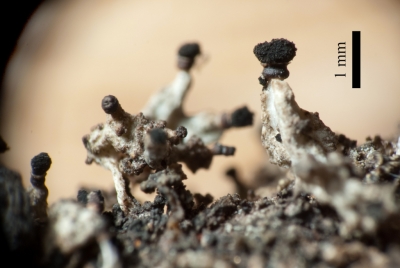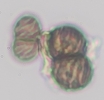<- Return to Table of Contents and Introduction
<- Return to Key to Genera
This section last updated: 2013-04-28
Monotypic: Tholurna dissimilis (Norman) Norman
Note: T. dissimilis shares many characteristics with Calicium adaequatum, and phylogenetic trees illustrated in recent genetic studies tend to show them closely grouped. It is my opinion that C. adaequatum should be transferred to Tholurna, which would allow the genus to be cleanly distinguished from Calicium on the basis of the pale, translucent ascomatal “stalk” and the ecology of the species inhabiting young, exposed substrates. However, retention of monophyly may require transfer of T. dissimilis to Calicium instead.
Tholurna dissimilis (Norman) Norman
External Links:
Morphology & Anatomy: Thallus superficial, granular to dactyliform, white-gray. Ascomata appearing stalked though the “stalk” is formed of thaline tissues with algae present, often translucent when wet. Spores __ μm, pigmented dark brown. Spore walls cracking at maturity with a distinctly spiral pattern.
Habitat: On young substrates, typically known from branches of young conifers and equivalent substrates near the top of older conifers, at mid to high elevations, often in bird-perch locations.
Distribution:
Notes: Compare with Calicium adaequatum, which has ascomata with smaller, true stalks (not containing algae) and is mostly known from hardwood trees and shrubs.





